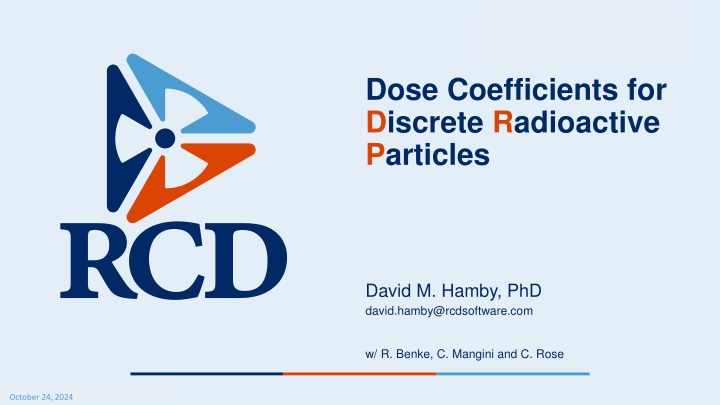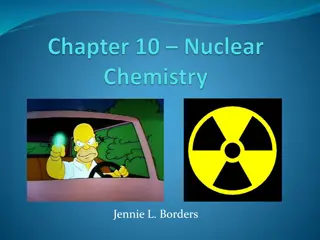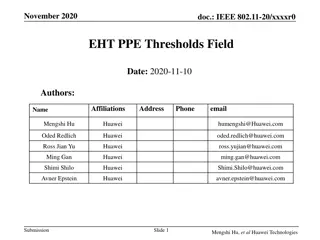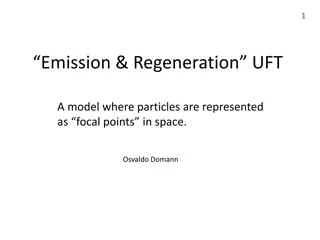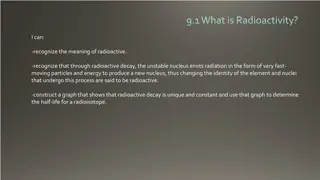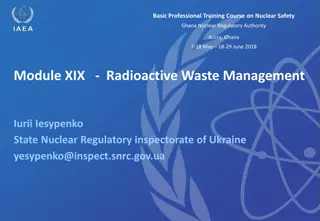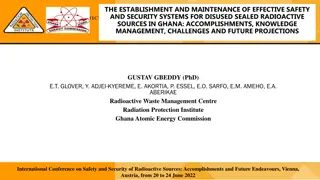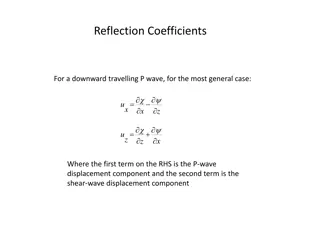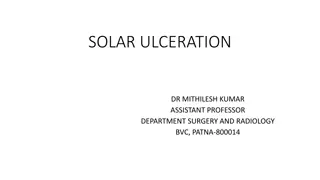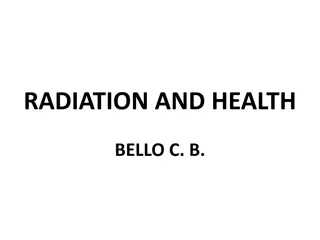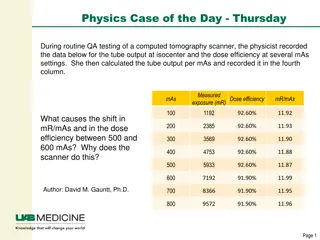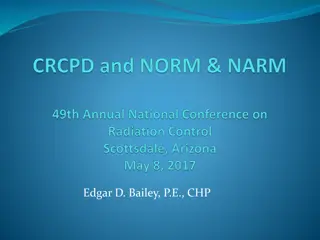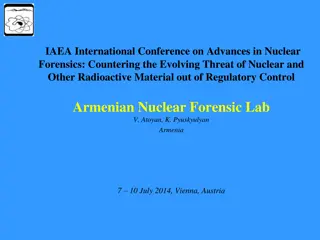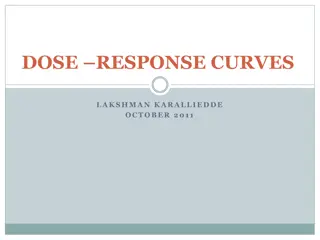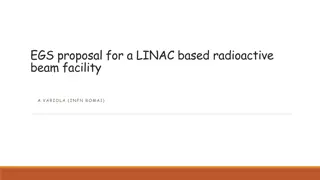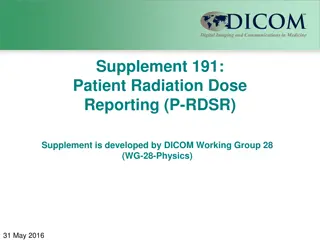Dose Coefficients for Radioactive Particles and Ulceration Thresholds
This content discusses dose coefficients for discrete radioactive particles (DRPs), their potential harm, exposure scenarios, ulceration threshold doses, and critical tissue depths. It covers the risks associated with DRP exposure, including skin, respiratory tract, and gastrointestinal impacts. The recommended ulceration dose threshold and critical tissue depths for different organs are highlighted. Understanding these factors is crucial for assessing and managing risks associated with DRPs.
Uploaded on Apr 23, 2025 | 1 Views
Download Presentation

Please find below an Image/Link to download the presentation.
The content on the website is provided AS IS for your information and personal use only. It may not be sold, licensed, or shared on other websites without obtaining consent from the author.If you encounter any issues during the download, it is possible that the publisher has removed the file from their server.
You are allowed to download the files provided on this website for personal or commercial use, subject to the condition that they are used lawfully. All files are the property of their respective owners.
The content on the website is provided AS IS for your information and personal use only. It may not be sold, licensed, or shared on other websites without obtaining consent from the author.
E N D
Presentation Transcript
Dose Coefficients for Discrete Radioactive Particles David M. Hamby, PhD david.hamby@rcdsoftware.com w/ R. Benke, C. Mangini and C. Rose October 24, 2024
aka Hot Particles DRP definition 10 1,000 m in any dimension insoluble in water of high specific activity DRPs are potentially harmful if on the skin [for a significant length of time] if inhaled or ingested and become stuck in the upper respiratory or gastrointestinal tract [for a significant length of time] The harm is generally deterministic and related to tissue ulceration or necrosis Uranium oxide from Chernobyl Table Salt (~ 300 microns) 2
Context: Site Release A decontaminated nuclear facility may contain residual radioactivity in the form of small specks in the soil These specks (DRPs) are usually located by intense site-closure surveys, but the possibility exists that a small number of DRPs could go undetected After site release, if one of these undetected DRPs is taken into one s body or becomes attached to the skin, the resulting local dose could be significant 3
DRP Exposure Scenarios Skin Surface Shallow Dose Equivalent Effective Dose Equivalent Upper Respiratory Tract Local Dose Equivalent (ulceration) Effective Dose Equivalent (stationary particle) Small & Large Intestine Local Dose Equivalent (ulceration) Effective Dose Equivalent (stationary particle) Ingestion CEDE 4
Ulceration Threshold Dose 25 Gy for deep ulceration and necrosis (IAEA 2020) 3.5 - 5 Gy for erythema and edema (HHS 2022) 25 Gy for ulcers and necrosis (Iddins et al. 2022) 5 - 10 Gy for erythema, desquamation, necrosis (ICRP 2012) Risk of ulcers and fibrosis 5% at 55 Gy; 50% at 70 Gy (EPA 1992) 1 Gy for acute ulceration (ICRP 1992) 20 Gy for deep ulceration (CDC 2020) 30 Gy ulceration anticipated (DiCarlo et al., 2020) 1 5 10 20 30 40 50 60 70 80 90 100 Dose (Gy) Recommendation: 25 Gy ulceration threshold 5
Critical Tissue Depths Recommended Ulceration Dose Threshold 25 Gy average absorbed dose delivered to 1 cm2 at the critical depth Critical Tissue (basal cell) Depths Upper Respiratory Tract 4.5 mg/cm2 Small Intestine 14 mg/cm2 Large Intestine 29 mg/cm2 6
DRP Materials & Nuclides Effective Atomic Number 33 29 10 88 74 Half-Life (years) Density (g/cm3) Nuclide Stellite 6 Co-60 Inconel 718 Ni-59 Ni-63 Regulatory Concrete Fe-55 Co-60 Ba-133 Eu-152 Eu-154 Fuel Fragment Sr-90 Cs-137 Eu-154 Eu-155 Pu-238 Pu-239 Pu-240 Pu-241 Am-241 Cm-244 Welding Rod Th-232 8.4 8.2 2.3 11 19 5.27 76,000 101 2.75 5.27 10.5 13.5 8.6 28.8 30.1 8.6 4.75 87.7 24,000 6,600 14.3 433 18.1 14 billion Stellite (cobalt alloy) Inconel (nickel alloy) Regulatory concrete Fuel fragment Thoriated welding rod w/ decay progeny 7
External DRP: Skin Surface Particle resting on the skin surface Modeled as spherical source w/ diameters from 10 to 1,000 m Bulk density and effective Z considered for self- shielding Shallow Dose Equivalent (SkinDose) tissue depth of 7 mg/cm2; 10 cm2 averaging Effective Dose Equivalent (PiMAL/MCNP) particle situated at the mid-torso results in largest EDE weighted (ICRP 26/30) sum of organ dose equivalents 8
Internal DRP: Local Dose Also, using the V+ SkinDose module Particle assumed to be stuck on the inner surface of the upper respiratory tract, small intestine, or large intestine Inner surface assumed to have no curvature (i.e., modeled as flat) focusing on highest local dose Local Dose Equivalent determined at critical depths Dose rate coefficients can be used to determine exposure time (or activity) required to exceed an ulceration threshold dose (25 Gy) 9
Internal DRP: EDE Again, using coupled PiMAL/MCNP DRP locations upper respiratory tract (nasopharynx, larynx) small and large intestine (various locations) DRP assumed to remain whole and stationary 10
Internal DRP: CEDE - Ingestion ICRP 30 gastrointestinal tract biokinetic model not originally intended for single-particle events assumed here to be valid for a DRP that moves with GI contents ICRP 26/30 tissue weighting factors CEDE coefficients for ingestion developed using IMBA 5.0.1 DRP remains whole and is moving through the body no activity to the bloodstream, i.e., f1 = 0 except for fuel fragments (f1 = 0.1) 11
Internal DRP: CEDE - Inhalation Large particles will be captured in the nasopharynx (NP) region In ICRP 30, particles with physical dimensions greater than 10 m are assumed not to go deeper than the NP region thus, most likely outcome for DRPs is removal through physical excretion (i.e., sneezing) and the DRP would not travel through the respiratory system A committed dose coefficient is not appropriate in this case 12
Stellite (Co-60) Estimated Maximum Dose Eq. [mSv] Reasonable Maximum Exposure Time [d] Time Time Dose Quantity Source Location Dose Coefficient Required for 0.5 Sv [d] Required for 25 Gy [d] 3.7x10-8 [Sv/Bq h] Skin Surface SDE 1 44 11 560 5.8x10-10 [Sv/Bq h] (mid torso) EDE 1 0.70 720 - 4.8x10-7 [Sv/Bq h] Upper Resp Tract Local DE 2 1,200 0.86 43 8.8x10-8 [Sv/Bq h] EDE 2 210 4.7 - 1.7x10-7 [Sv/Bq h] Small Intestine Local DE 0.5 100 2.5 120 5.9x10-8 [Sv/Bq h] Large Intestine Local DE 5 350 7.0 350 2.7x10-9 [Sv/Bq h] GI Tract EDE 5 16 150 - 1.8x10-9 [Sv/Bq] Ingestion CEDE - 0.090 - - *in this example, the DRP is assumed to have a diameter of 100 microns and Co-60 activity of 50 kBq 13
Fuel Fragment (Eu-154) Estimated Maximum Dose Eq. [mSv] Reasonable Maximum Exposure Time [d] Time Time Dose Quantity Source Location Dose Coefficient Required for 0.5 Sv [d] Required for 25 Gy [d] 8.1x10-8 [Sv/Bq h] Skin Surface SDE 1 16 32 1,600 3.1x10-10 [Sv/Bq h] (mid torso) EDE 1 0.060 8,400 - 9.6x10-7 [Sv/Bq h] Upper Resp Tract Local DE 2 370 2.8 140 4.3x10-8 [Sv/Bq h] EDE 2 17 60 - 5.6x10-7 [Sv/Bq h] Small Intestine Local DE 0.5 45 4.6 230 3.5x10-7 [Sv/Bq h] Large Intestine Local DE 5 340 7.4 370 1.5x10-9 [Sv/Bq h] GI Tract EDE 5 1.4 1,700 - 1.9x10-9 [Sv/Bq] Ingestion CEDE - 0.015 - - *in this example, the DRP is assumed to have a diameter of 100 microns and Eu-154 activity of 8 kBq 14
